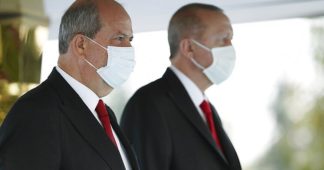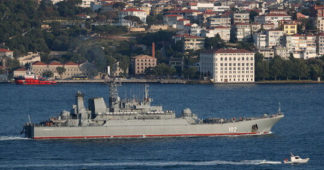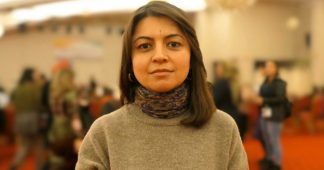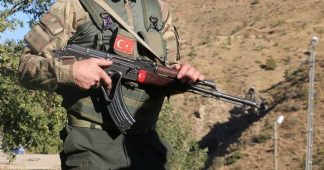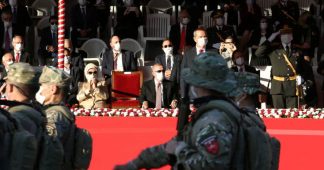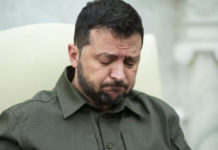By
On December 16 and 17, Democracy Today, an NGO that focuses on human rights issues, organized its annual international conference in Armenia’s capital of Yerevan. This was part of a cooperation with the Working Group (WG) on women and gender realities in the Organization for Security and Co-operation in Europe (OSCE) region.
This year’s agenda of the conference was “displacement of women: gender implications and search for viable solutions to protect human rights.”
I was invited to join the conference as an online panellist and my topic was “The Case of Cyprus: Turkish occupation and unpunished crimes against women and children”.
Below is the full text of my speech:
“Villagers Driven from Cyprus Homes Charge Murder and Rape by Turks”
This was the title of a news report of the New York Times on Aug. 6, 1974 covering Turkey’s invasion of Cyprus.
The report said, in part:
“Greek Cypriots from small villages around Kyrenia told stories today of murder, rape and looting by the Turkish Army after its invasion of Cyprus. The villagers are among 20,000 civilians driven from their homes by the Turks along the northern coast of the island.
One ashen‐faced man told tearfully how his wife and two young children were shot before his eyes by Turkish soldiers who rounded up villagers before shooting them. A married woman whose husband was shot by the Turks and young girl who saw her fiancé shot told how they were then raped at gunpoint by Turkish soldiers.
Since the invasion began Greek Cypriotes in the Kyrenia area have fled in thousands to friends and relatives in other parts of the island, Those presented to journalists were among a group who are being cared for in an orphanage just across from the Hilton Hotel in Nicosia. Like the rest they fled with the clothes they wore and a few bare essentials.
Mrs. Mateidou said she and her family had just got to sleep on July 24, after the first cease‐fire was to have gone into effect, when the village was surrounded by Turkish troops. “We went out with hands raised but the Turks started beating us,” she said. “They took off the top clothes of my husband and father‐in‐law and led them to the river bed in the village. Then they were shot. The women of the village were taken to the house of a British woman who had been evacuated, They were there raped at gunpoint.”
Another young woman, aged 20, who refused to be identified, told of how she was raped, after she had seen her fiance machine‐gunned with other men in her village. “When my fiancé was killed I threw myself into a ditch to hide —I was terrified,” she said, adding: “As I was lying there a Turkish soldier grabbed hold of me. He threw me, to the ground and tore off my clothes. I tried desperately to escape but he was holding me at gunpoint. He said he would kill me.”
“At one point another soldier came up with a baby in his arms. He asked who was the mother. I thought if I said it was mine it might save me. However, when I said I was the mother he threw it to the ground.”
In 1974, the UN and the rest of the international community looked the other way.
After 1974, in the case of Cyprus v Turkey, allegations of rape were among the gross human rights abuses investigated by the then European Commission of Human Rights, a body of the Council of Europe. The investigation resulted in a Report adopted in 1976, initially covered up, leaked to the British Sunday Times in 1977 and eventually declassified in 1979. On the issue of rape, the European Commission concluded: “The evidence shows that rapes were committed by Turkish soldiers and at least in two cases even by Turkish officers, and this not only in some isolated cases of indiscipline. …”. This meant that “by 12 votes against one”, that “the incidents of rape … regarded as established constitute ‘inhuman treatment’ in the sense of Art[icle]. 3 of the [European] Convention [on Human Rights], which is imputable to Turkey.” Despite this,
In 2016, Cyprus News Agency (CNA) secured the testimonies of two women who alleged that they had been raped repeatedly, Anna – not her real name – from a village in Kyrenia district and Maria – not her real name – from a village in Famagusta district. Both of them were fourteen years old in 1974.
The following was Maria’s story as reported by the CNA:
“Maria`s father, working in animal husbandry, did not want to leave his animals when war broke and so the whole family remained enclaved.
“We went to the fields, outside the village. We were about hundred people, four days hiding. The night became day. They threw flares and knew we were hiding. We heard tanks on the road going back and forth endlessly. They threw leaflets from a helicopter, depicting half of Cyprus painted white and the other half red and ordered us to surrender, otherwise they would kill us.
“We returned to the village, surrendering, arms up in the air. We saw people lying dead on the road. They gathered us in the school yard. They separated the men from the women, the babies, the elderly over sixty, and put them in classrooms. Two trucks loaded the prisoners of war. My father was one of them.
“My mother, my six-year-old sister and I were taken with other women and put in the last houses of the village. On the first night they came to count us. They dragged me and other girls and led us to nearby fields, in darkness. My mother tried to pull me away from them but was hit by a gun. They pulled me by force, outside. They raped me repeatedly. I pleaded with God to help me. I screamed. I was only fourteen. They had their fun and took us back. I heard the women in the house talking about leaving the kitchen gas supply on to commit suicide, to save ourselves from this torment.
“Every night this same scene was repeated. We tried to hide in the attic of the house, but they found us and dragged us by the hair. This torture continued for two to three months,” Maria recalled, tears rolling from her eyes”.
These people were among the 200,000 citizens of the Republic of Cyprus (mostly though not all of Greek ethnicity) who were forced to flee their homes and lands in the northern part of the Republic of Cyprus during Turkey’s two invasion campaigns in the summer of 1974. In addition to citizens of Greek ethnicity, Armenian, Maronite, and other non-Muslim Cypriots were also forcibly displaced. So, too, were citizens of the Republic of Cyprus of Turkish ethnicity. In line with the demands of Turkey and their local agents, they were forcibly uprooted from their homes in the south and, with the help of the United Kingdom and its Sovereign Base Areas adjacent to the Republic, they were arbitrarily relocated to the north. This mass – but unpunished – ethnic cleansing facilitated a pre-existing Turkish scheme to alter the demographic character of the Republic of Cyprus. Women and children suffered immensely.
Since 1974, Turkey has forcibly and illegally occupied around 36 % of the sovereign territory and 57% of the coastline of the Republic of Cyprus. The occupying Turkish regime in the north is not recognized under international law.
Amid a climate of impunity that continues to this day, many well-documented but unpunished atrocities were committed by Turkish occupation forces during each of its two invasions launched on 20 July and 14 August 1974. Civilians, including children were unlawfully killed, raped or otherwise subjected to inhuman or degrading conduct. Many were arbitrarily detained by the Turkish military authorities and placed in what amounted to concentration camps. The detainees were tortured or exposed to other types of inhumane treatment, including performing forced labor. Homes and business premises of those who had to leave were looted, seized, and arbitrarily appropriated. Furthermore, churches, monasteries and cemeteries were desecrated or allowed to fall into a state of disrepair.
Among these is an historic Armenian monastery in the Turkish-occupied north of the Republic of Cyprus. To quote from a publication of its Government:
“The monastery of Sourp Magar (Ayios Makarios) is the only Armenian monastery in Cyprus and the most important Armenian ecclesiastical site on the island… Because of the Turkish invasion and the abandonment of the Monastery, it is in a ruined state, and parts of its walls and roof have collapsed.”
Professor Van Coufoudakis notes in his 2008 report “Human Rights Violations in Cyprus by Turkey”: “Evidence of the gross and continuing violations of human rights by Turkey in Cyprus come from, among others:
- Eyewitness accounts
- NGO investigations
- Various international organizations
- The European Commission of Human Rights
- The European Court of Human Rights
- Reports by international media”
In their article titled “Gender and Genocide: Armenian and Greek Women Finding Positive Meaning in the Horror,” scholars Artemis Pippinelli and Ani Kalayjian detail the sexual assaults by Turkish troops against Greek Cypriot women and children, which they call the “Cyprus gendercide.” They write:
“Rape victims suffered severe gynecological problems as well as psychological trauma. In some cases, women were forced into prostitution. Many were collected from different villages and held in separate rooms of empty houses where they were repeatedly raped by Turkish soldiers. In other cases, members of the same family were repeatedly raped, some in front of their children. Rapes also occurred in public before spectators. The brutality of these violent sexual attacks was followed by extreme physical trauma, including near suffocation. Children and pregnant or mentally retarded women were not spared.”
Today Turkey still calls the atrocities it committed in 1974 “a peace operation.”
In effect, displaced persons of non-Turkish origin, including Armenians, continue to be barred from returning to their homes or rebuilding their lives in the ancestral towns and villages from which they were forcibly expelled. Many of their churches have been plundered, arbitrarily converted into mosques, locked up or allowed to fall into a state of disrepair. Since 2019, the Turkish government has been opening fenced-off parts of the city of Famagusta although it legally belongs to the Republic of Cyprus. This illegal reopening also means further destruction of the indigenous Greek cultural heritage there. For instance, the Cultural Center of Lykion Ellinidon (Gymnasium for Girls) was recently Turkified, albeit on a de facto basis.
Another consequence of the conflict culminating in Turkey’s invasion of Cyprus is that many citizens of the Republic of Cyprus remain ‘missing’. According to the UN-backed Committee on Missing Persons in Nicosia, 779 ‘Greek Cypriot missing persons’ and 201 ‘Turkish Cypriot missing persons’ are ‘still missing’.
A further consequence has been the transformation of the Turkish-occupied north of the Republic of Cyprus into magnet for human traffickers who have trafficked vulnerable women as well as children at risk of being sexually abused or otherwise exploited. The annual US State Department Reports on Human Trafficking make that reality abundantly clear. I quote just a few sentences from page 205 of the latest Report published in 2021:
“[During the last year the de facto] Turkish Cypriot authorities did not investigate, prosecute, or convict any traffickers. Turkish Cypriot authorities did not identify any trafficking victims and provided no victim protection, including shelter and social, economic, and psychological services. Turkish Cypriot authorities did not allocate funding to anti-trafficking efforts or provide training on anti-trafficking issues. … Despite business closures due to pandemic mitigation measures, night club owners continued to force victims into sex trafficking.”
Conclusion
Despite all this, the UN has never established an international war crimes tribunal for Cyprus, as it did, fore example, for the Former Yugoslavia.
Many women and children who were victims of Turkey’s aggression in 1974, as well as their children and grandchildren, are still forcibly displaced persons unable to return to their homes, pray in the churches where they were baptised or pursue a meaningful life in lands which have been ethnically cleansed and subjected to the destruction of cultural heritage. They are constantly living with the memory of the many unpunished war crimes and crimes against humanity committed against them and their families.
Despite these realities, the UN, the European Union (of which the Republic of Cyprus is now a member state), the rest of the international community and human rights organizations have largely failed to address these crimes. This is a continued injustice imposed on the island country by Turkey. However, ensuring that the most severe crimes do not go unpunished and promoting respect for international law should be one of the first agendas of human rights defenders.
47 years after Turkey’s invasion, the occupied northern part of Cyprus remains a crime scene. It is one of the biggest cases of ongoing colonization, ethnic cleansing and cultural heritage destruction. However, by combating impunity – particularly in relation to crimes against children and women (and upholding the rule of law), justice could still be secured for the victims of Turkey’s severe violations against Cyprus and violations in other areas by other powers.
Sadly, the international community does not seem to comprehend the full scope of Turkey’s atrocities in Cyprus. They are not aware – or do not want to be aware – of the extent of the impunity Turkey enjoys and how it has affected the wider region. And as long as the Turkish government is not brought to account for its crimes against Cypriots, other nations, women and children – will continue being at risk of similar crimes and atrocities at the hands of aggressive, tyrannical regimes
Published at moderndiplomacy.eu
We remind our readers that publication of articles on our site does not mean that we agree with what is written. Our policy is to publish anything which we consider of interest, so as to assist our readers in forming their opinions. Sometimes we even publish articles with which we totally disagree, since we believe it is important for our readers to be informed on as wide a spectrum of views as possible.
